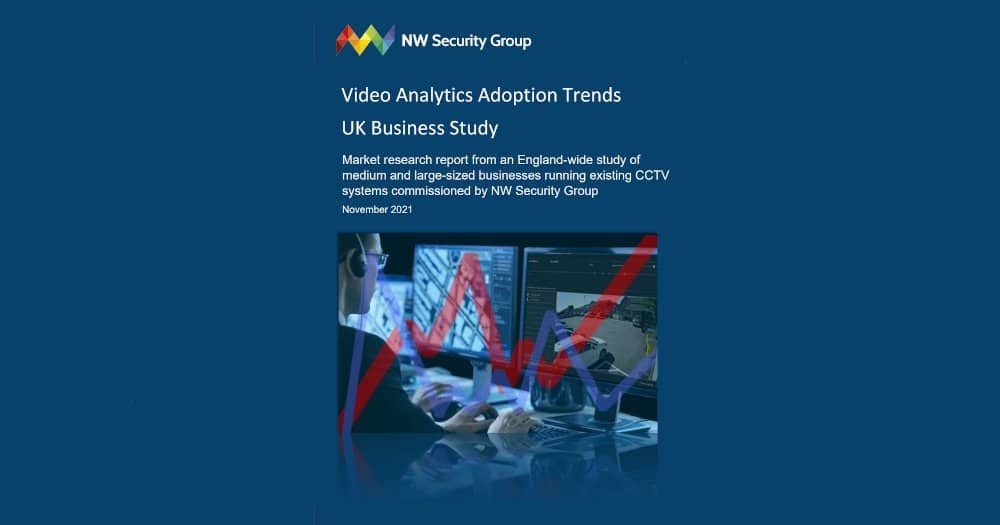NW Security Group has launched management report entitled ‘Video Analytics Adoption Trends UK Business Study’. The report brings together all results and analysis from a comprehensive, England-wide market research study of 152 medium and large sized firms running CCTV systems completed over the last six months.
England is set for near doubling of most popular video analytics tools
The report reveals that eight of the total 14 video analytics types which were included in this study had seen more than 30% adoption and use by businesses running their own CCTV systems across England.
The ‘Top 8’ video analytics types are, in order of level of adoption and in use live in video surveillance systems: Facial Recognition (41%), Event and/or Behavioural Analytics (36), ANPR (34%), Video Motion Detection (34%), Auto Tracking (33.33%), Object Detection and/or Object Classification (32%), Directional Detection analytics (31.5%) and Optical Character Recognition (OCR) (31%).
By including the group which already has access to some video analytics in their systems today but have not yet made these capabilities live, the adoption percentages rise to over 50% for all 14 key video analytics tools tracked in this study including Traffic Monitoring, Heat Mapping, People Counting and Facial Detection analytics.
Frank Crouwel, Managing Director, NW Security Group explains: “The fact that market penetration, once users have turned existing analytics capabilities on, has already exceeded 50% of the total medium and large-sized business market is significant.
“If you scan across to Geoffrey Moore’s famous Technology Adoption Curve, it becomes clear that video analytics adoption is starting to reach into Late Majority ‘conservative’ users who are characterised by an expectation that the technology they use needs to work ‘out of the box’. This group don’t want to devote significant resources to analytics deployment.
“However, the reality is that most of the video analytics technologies we studied simply do not work well out of the box. They require considerable expertise to set up and configure both the hardware and software correctly. Without this expertise, the risk is that when the new analytics capabilities are turned on, they generate an increase in false negatives and positives which only serves to increase the burden on the user rather than reducing it,” Frank Crouwel added.
False positives and negatives rising with video analytics adoption
In this context, NW Security’s study found more than 9 out of 10 (93%) businesses running CCTV systems with video analytics capabilities still find they are generating too many false positives or negatives linked to poor installation, maintenance or configuration.
More specifically, 27% of all system decision-makers reported an excess of false positives and/or negatives being generated by their CCTV systems because of incorrectly specified or configured video analytics software. Just 7% of systems with video analytics in use today reported receiving no significant false alarms from their systems.
Over hype risks disillusionment…again
There is also clear evidence that video analytics vendors are sometimes guilty of over-promising and confusing the market with the language that is used in their sales and marketing literature:
NW Security’s research discovered that a third (33%) of system owners found the language vendors use in sales and marketing literature (such as AI Analytics, Deep Learning, Analytics+ and Smart Motion Detection) confusing. Nearly one in three (28 per cent) went further to declare vendors’ literature ‘misleading’ and containing ‘too much over-promising’.
However more positively, 30% of firms believe that the video analytics software they use does help reduce false alarms in their systems – rendering systems more accurate.
Access to expertise is key to successful adoption
The report also probed how CCTV system owners are resourcing the upgrading, management and maintenance of their video surveillance systems. Nearly four out of every five (79.6%) CCTV systems are still managed entirely in-house.
Control is shared in this group fairly evenly between the in-house IT department (with 41.7%) and Facilities Management or Security departments (with 37.9%). That leaves just one in five (20.4%) which work with an external service provider of some sort: 13.6% of this group use an outsourced managed security service provider, while just 6.8% use an expert CCTV installer/integrator.
Analytics can bring access to ‘beyond security’ benefits
Deeper analysis in the report finds that video analytics which brings operational business benefits beyond traditional security protection, are more widely adopted in companies where external experts are involved. For example, use of video security systems for Health & Safety benefits (including making workplaces COVID Safe) are more widespread amongst firms which use an external security services provider.
Over three quarters (76%) of firms using external support have been able to extend their video systems into supporting Health & Safety requirements, as opposed to 63% which have been able to do this if they are running their CCTV systems entirely in-house.
Furthermore, 86% of businesses using external security providers are using their camera systems to monitor equipment, production processes or operational procedures, as against 73% of businesses able to realise these benefits if they are running their CCTV systems entirely in-house.
There was also evidence that where external support was being used in the security function, integrated thinking around cyber and physical security resilience and personal data protection was more prevalent.
External service provision stimulating holistic cyber & physical security resilience
Nearly half (43%) of all companies supported by an external security specialist had a live ‘top priority’ project ongoing ‘designed to harden all networked systems to combat cyber security threats‘. Whereas for firms running their CCTV systems in-house, just 35% of them were focused on hardening their physical security systems against cyber-attacks this year.
Over half (52%) of all firms supported by external security specialists had a top priority project running to improve the ‘GDPR compliance and data protection procedures surrounding our CCTV system’. Whereas for firms running their CCTV systems entirely in-house, 45% of them were focused on improving their GDPR compliance capabilities associated with their physical security system by the end of 2021.
Frank Crouwel, Managing Director of NW Security, commented: “Not only is there a reality of the complexity of video analytics’ set up and configuration which makes calling in the experts worthwhile, but also it can help with exploring and exploiting other operational benefits for video systems which often go beyond pure traditional physical security.
“Analytics after all is not only about adding accuracy to security systems and improving incident detection rates, but also enabling video systems to deliver powerful business intelligence and unlocking operational benefits which have been rarely considered beforehand.”
A copy of NW Security’s full report is available here: https://www.nwsystemsgroup.com/our-company/market-research-report-uk-video-analytics-adoption-trends-2021





